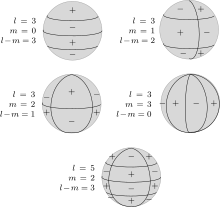Tesseral
As tesseral mathematical functions are called, with which one phenomena on a surface can describe that a chessboard have -like history.
Spherical surface functions or mass functions
In the geosciences , tesseral spherical surface functions are used to computationally analyze both width and length-dependent phenomena. In contrast to this, only width-dependent terms are referred to as zonal , only length- dependent terms as sectoral . The dynamic satellite geodesy used tesseral since the early 1970s harmonic functions to the Ground Features - the variations of the Earth's gravity field from that of a theoretical earth ellipsoid - to describe. In the first years of satellite geodesy (1958 to around 1970), however, it was only possible to derive zonal parameters from the satellite's orbital disturbances .
The largest zonal parameter J2 (which is called C {2,0} in the more recent notation of harmonic series developments ) represents the flattening of the earth , the 21 km difference between the equatorial radius and the polar radius of the earth. The next larger mass functions J3 and J4 (in today's series developments called C {3,0} and C {4,0}) only make up about 15 meters in the earth figure , while the largest length-dependent coefficient C {2,2} the ellipticity of the earth equator and means about 50 meters altitude deviation.
The other tesseral terms are only in the meter to decimeter range and can now be calculated from satellite orbits up to around order 70 (symbolically C {n, m} and S {n, m}, n = 2… 70, m = 0 ... n), while in combination with terrestrial gravity measurement they are already determined up to order n = 720. This corresponds to a mathematical description of the ( inherently irregularly curved) geoid with a spatial resolution of about 30 km. More precise details must be determined by local measurements and “superimposed”. Such data is obtained over the sea by methods of satellite altimetry , on the mainland by gravimetry or by measuring deviations from the vertical .
Occupancy
Besides the harmonic spherical function expansions, there are other methods to calculate tesseral phenomena on earth. One of the most important is the method of surface covering , which was developed by Karl Rudolf Koch (University of Bonn) in the 1970s. A constant correction value (" potential of the simple layer ") is assigned to a square or spherical area of the earth's surface , which changes abruptly at the border to the next square. As a result of these jumps , the method is discontinuous , but with the same resolution it gets by with considerably fewer parameters than the methods with harmonic coefficients .
Multipoles
Another, relatively often used method is that of multipoles , in which any mass distribution (e.g. in the deeper crust of the earth or in the earth's mantle ) is approximated by conveniently placed mass points . Major further developments of this method can be traced back to Bernhard Hofmann-Wellenhof (Graz University of Technology).
literature
- Karl Ledersteger : Astronomical and physical geodesy (earth measurement). JEK . Volume V, Chapters 6, 7 and 12. Metzler, Stuttgart 1968.
- Rudolf Sigl , E. Groten: Dynamic Satellite Geodesy. An overview. DGK . Series A, Volume 49. Munich 1966.
- Günter Seeber : Satellite Geodesy. de Gruyter, around 1975 and 1995.
- Manfred Schneider : Celestial Mechanics. In 4 volumes. Volume I and III. Munich 1995 and 1999.
- Wolfgang Torge : Geodesy. de Gruyter, Berlin 1975. English edition: Geodesy. 2001.
Web links
- Satellite geodesy at the University of Bonn.
